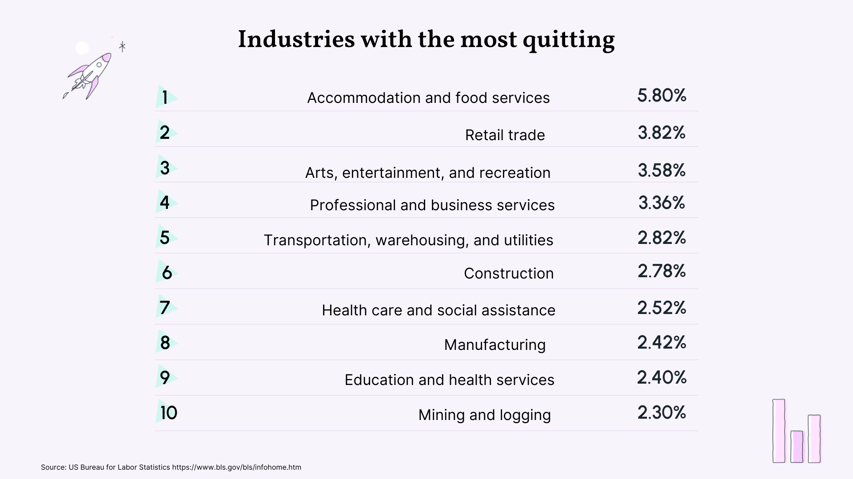Although we are no longer seeing those "we all quit" posters at our favorite food chains, hiring and employee retention continue to be one of the biggest challenges that businesses of all sizes face today. Why?
Research shows toxic work culture is the key problem.
A recent MIT Sloan Management Review study determined that the leading cause for the Great Resignation was actually a toxic workplace culture.
In fact, the study stated that toxic workplace culture is "10 times more important than compensation in predicting turnover."(Read that again and slowly. 10. Times!)
Although the Great Resignation is now theoretically over (we’ll get into that later), some of the same pain points that led employees to quit their jobs are affecting companies across the country.
Let’s dive into what’s happened, where we are now and hear from the pros on how you can get the best people and avoid losing them.
Reflecting on the Great Resignation in 2023
Between April and September of 2021, more than 24 million American employees left their jobs in an unprecedented phenomenon that many called the Great Resignation. This got even worse as 50 million people walked out on their jobs in 2022.
But why did this happen?
The COVID-19 pandemic was a catalyst. Quarantine and stay at home policies gave employees the time to slow down. It provided a unique break to reconsider how and where they wanted to work. Many decided that dealing with workplace dysfunction just wasn't it.
Remote work also revealed the possibility of work-life balance and increased autonomy. This left many dissatisfied with their traditional work setups.
Some people took this opportunity to retrain or switch jobs and never looked back.
Is the Great Resignation over?
Honestly, the answer to that question is a solid maybe.
PwC's '2023 Hopes and Fears Global Workforce Survey' polled 54,000 workers across 46 countries and found that a quarter of these workers expect to change jobs in the next 12 months. It’s clear that employee discontent is still very much top of mind across the globe.
Yet, we are not seeing mass quitting at the level that we experienced in 2021 and 2022. In fact, the Labor Department’s Job Openings and Labor Turnover survey showed that in March 2023, the number of quits decreased to about 3.9 million in the United States, the lowest level since May 2021.
Some experts are declaring that the Great Resignation has turned into the big stay: where employees are staying put at their current roles with no desire to move.
But does that mean that people are staying at their job because they are passionate about it? Or are they staying for the security of it in the face of uncertain economic times?
Hiring in a recession
As any HR professional would tell you, hiring is incredibly difficult right now. And, keeping those new hires is sometimes even harder.
It seems like the most important thing to focus on here is:
- What leads staff to leave?
- How can you ensure your employees don’t leave once the economy settles or a better opportunity shows up?
- If we get another Great Resignation, how will you be impacted?
- How do you make sure that your employees are staying for the right reasons?
The Great Resignation may not be the biggest worry on your mind, but employee priorities have changed and you need to make sure you’re the company they choose.
Culture is paramount
At a time when everyone and their uncle are concerned about the rising inflation and upcoming recession, a company's culture is still the most important factor to predict if employees will stick around or search for greener pastures.
With numbers like these, it’s a wonder that this isn’t the most talked about topic in HR forums. Let’s break it down and figure out what you need to do to avoid being a part of the problem.
Toxic work culture: What exactly is it?
Toxic corporate culture has played a pivotal role in pushing employees to the brink of leaving. When people spend a significant portion of their lives in a toxic work environment, it takes a toll on their mental and physical well-being.
What exactly do we mean by ‘toxic’, though? Let’s break it down.
Toxicity can manifest in various forms:
- Micromanagement
- Lack of trust
- Bullying
- Discrimination
- An absence of work-life balance
These factors contribute to an environment that erodes employee morale, stifles creativity, and hampers productivity.
Not all industries are equally toxic
Just like your exes, not all industries are equally toxic. In fact, data from the U.S. Bureau of Labor Statistics showed that industries like accommodation and food were by far the industries that most workers were leaving.
It’s no surprise that jobs known for long working hours, dealing with disgruntled and often rude customers, and having unclear role designations saw an average of 5.8% quit rate per month in 2022.

How to tell if your work culture is toxic
I was once interviewing for a job and I asked my potential employer how they handled work-life balance. She shrugged and told me it was a fast-paced environment and “either you keep up or you won’t make it”. I ran for the hills.
The thing about toxic workplaces is that the people in them often just don’t see it. Here’s how to keep a watchful eye and make sure you’re not the problem.
Forbes says that there are 8 signs that your workplace may be less than ideal to look out for. They are:
- Inexplicable turnover
- Lack of transparency
- Gossip among employees
- People pointing fingers at others
- Passive-aggressive behavior
- Unmotivated employees
- Low team morale
- Division among departments
Look out for these signs and make sure to understand what is happening exactly and, more importantly, why it is happening.
- Do the people in your organization not feel like they can speak up?
- What are the channels for feedback that are available and how can you improve upon them?
- Is there a change in shift since a recent hire came on that may be throwing your culture off?
Remember to always come at these problems with an open mind and think about solutions, not where to place blame. You don’t want to be a part of the problem.
Attracting and retaining talent
One of the things that businesses often don’t realize is that when interviewing a new candidate, they are also interviewing you. And those red flags? Well, they show.
I was talking to my cousin the other day who is currently taking a leave from her work as a teacher to be with her baby and pursue her master's degree.
Her previous role had an incredibly toxic environment. When talking with her coworkers, it's easy to see that employee burnout is the standard across the whole team, and ineffective communication and unrealistic expectations has had a really negative impact on the company's work culture.
We were talking about how this break can be an opportunity for her to reevaluate what she wants out of her career. To determine what she’s willing to put up with or not. And, more importantly, how to include what she wants from a workplace in her selection process for a new position. It's no surprise that as she starts to evaluate where she wants her career to go in a year or two once she rejoins the workforce, one of the top things on her mind will be evaluating these new workplaces to make sure that she’s never stuck a toxic work culture again.
Having honest conversations about what is to be expected at work for somebody coming into your team can make a massive difference to attract top talent. It also makes sure that the people joining your team align with your core values and will continue to grow with you as time goes on.
It's so important to keep in mind that employees are thinking much more about what a workplace can provide for them than they used to. So be proactive and clearly communicate your organizational values and priorities to incoming and current employees.
This is how you’ll ensure you find your best-fit team and manage to keep it in the long term.
3 strategies for employee retention from HR pros
It’s one thing to ensure you’re adding new hires that fit your business, but it’s just as important to make sure the people you have stay with you.
The best retention strategy is always going to be staying ahead and not waiting until your employees start leaving.
We interviewed an array of HR professionals and learned some of the strategies that they've deployed to increase retention and create a healthy work environment. Here’s some of what they shared:
Exit interviews
“When people leave, we ask them what we could have done better to keep them as an employee,” an office manager at a McDonald’s franchise said.
Holistic benefits
“We promote our benefits like Earned Wage Access and our flexible scheduling” the General Manager at a Hospitality Group mentioned.
Make job listings clear
“Knowing what you’re getting into is half the battle”, an HR manager at the University of Texas mentioned.
Offer counter-offers or pay raises proactively.
Although culture is arguably more important than compensation, making sure you’re ahead of the game in how you pay employees shows that you care. “I worked with engineers who got a lot of offers, so we followed up with counter-offers to retain our employees,” a Senior HR Business Partner offered.
Overall, the most important thing is keeping open communication with your employees and backing them up with actions that are aligned with your core values. If you’re consistent and analyze what’s happening, you’ll be able to stay ahead of the game whatever comes your way.
It's not a lost battle
We don’t know if there’s going to be another Great Resignation. But one thing the experts seem to agree on is this: start from the inside out. In a time where workplace trends have more names than Taylor Swift has eras, it is essential that we focus on creating the kind of environment that makes our employees thrive and our businesses succeed in the long run.
How to retain and empower employees
You want to take care of your employees by helping them be empowered at work and in their financial journey. And, when workers know you’ve got their back, they’ll give you their best.
Employers who offer financial empowerment with Earned Wage Access significantly boost retention and decrease turnover. Talk to a ZayZoon expert today to learn more and get started in as little as 30 minutes.
.jpg?width=290&name=SusyA-Photo%20(1).jpg)






.jpg)